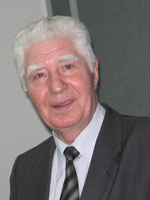Russian Virtual Computer Museum. → Rogachev Urii Vasilievich
Rogachev Urii Vasilievich
Permanent member of the “Russian Virtual Computer Museum”

Born 18 August of 1925 in town of Kalinin (now Tver) area.
In the 1943-1950s radio master at the Soviet Army. In August of 1945 participated in the Soviet military operations against Japan in Manchuria. After that he graduated from military radio courses and, from 1946, continued military service as radio master.
When Rogachev eventually was released from the army he worked (06.1950 – 09.1952) in Moscow at the Power Institute – research center of the USSR Academy of Sciences. There he was an electromechanician at the academician I. Bruk's laboratory of electric systems.
The Isaak Bruk's team of young university graduates was constructing the first (in Moscow) digital electronic computer M-1. Rogachev helped his young chief Nikolay Matyukhin, then 24, with development of new components and arithmetic unit of the computer. Rogachev himself replaced tube diodes in logic circuits with small-sized cuprous oxide rectifiers CVMP-2 (КВМП-2-7) and proved efficiency of their usage in electronic systems. Thus the M-1 became the world-first digital computer with semiconductor logical units.
In 1951-52 he completed gymnasium course, what was necessary for entering university, and then (1952-1958) studied at the Radio Faculty of the Moscow Power Engineering Institute (the most advansed place to study electronics, that time).
After graduation Rogachev returned to Bruk, who was already the founding-director of the new Institute of Electronic Control Machines (IECM). There he became an assistant of Mikhael Kartsev (1923-1983) at development of new computer М-4 (1958-60). Kartsev himself later became one of the most prominent Soviet computer scientists and designers.
Since then Rogachev always remained Kartsev's nearest friend, assistant and active participant of all his projects. Most famous of them were:
- computer M-4M (M-4 + UPO), 1960, for ultrahigh frequency band radar station control. Signals of the station arrived in higher tempo, and needed higher performance, then M-4 could provide;
- serially produced М4-2М – powerful computation system for antimissile defence (1962);
- systems of peripheral devices SVU-79-1 and SVU-79-2 designed for composing computation structures and local computing network MAEWS (missile attack early warning system) 1965-67.
Designing of computation complexes and components for М4-2М also formed scientific basis for his candidate of sciences thesis. He received scientific degree in 1967.
Since 1967 Rogachev was the chief-engineer at the IECM affiliate №1 (design bureau “Vympel”/pennon/), the place where M. Kartsev's pioneer project “cluster computer” (pilot-project of computer М-9) had been developed.
In 1969, third-generation multiprocessor vector-parallel computer М-10 was developed there (which inherited many basic pioneer ideas of M-9) as well as the computing complex for MAEWS control сentre (MAEWS CC).
In 1976, the first М-10-based computing complex was successfully integrated into MAEWS CC and put in routine operation. The Affiliate №1 was transformed into Scientific Research Institute of Computation Complexes (SRICC)
Rogachev and his colleagues were awarded the USSR State Premium (USSR State Prize) for their scientific contribution.
Since 1977 computer M-10 was manufactured in modernized version – M-10M. Computers M-10 and M-110M were fully soft-and hardware compatible, they served as basis for numerous specialized computing complexes 5К-31, 5E-52, 63I-6, 65I-6, 68I-6, 17L-6, 70I-6, 76I-6 for defence and other purposes.
The next successful project of Kartsev's team was -principally new- supercomputer М-13 – multiprocessor, vector parallel-conveyor computing system. Performance of its central processor unit surpassed 50 million ops, maximal equivalent performance of the functions processing unit reached 2.4 milliards ops.
From 1980 till1983 Rogachev was the deputy of M. Kartsev (the author and chief-designer of M-13). After Kartsev's death, in May 1983, he was appointed as the director of SRICC and as the M-13 chief-designer.
Only through his energetic efforts the administrative chaos caused by absence of Kartsev was successfully overcome and M-13 the most modern computer of its time was eventually put into industrial production.
In 1988 Yury Rogachev retired as a director, however, he remained as the director-general's scientific consulter. He was also elected into the board of directors of the SRICC named after M. Kartsev.
Since 1997 Rogachev is the cairman of this board.
In 1998 he published a book “Computing Machinery from M-1 till M-13 (1950-1990)” dedicated to M. Kartsev's memory. The book displays the entire creative biography of the institute's scientific team and their role in development of the Soviet computing.
Yury Vasilievich Rogachev is awarded with the orders: “The Great Patriotic War” (1985), “Sign of Honour” (1971), and with numerous medals, among them, “For Honourable Radiomaster”, “Victory over Japan”, “For Valorous Labour”, “100 years Jubilee of V.I. Lenin”, and some others..


